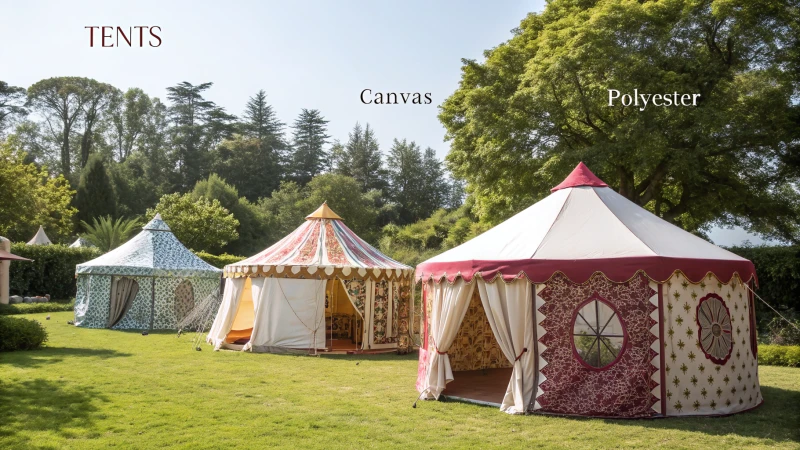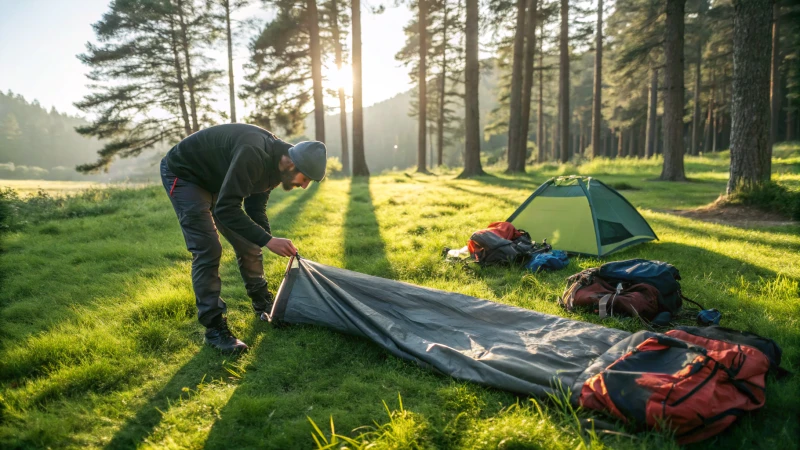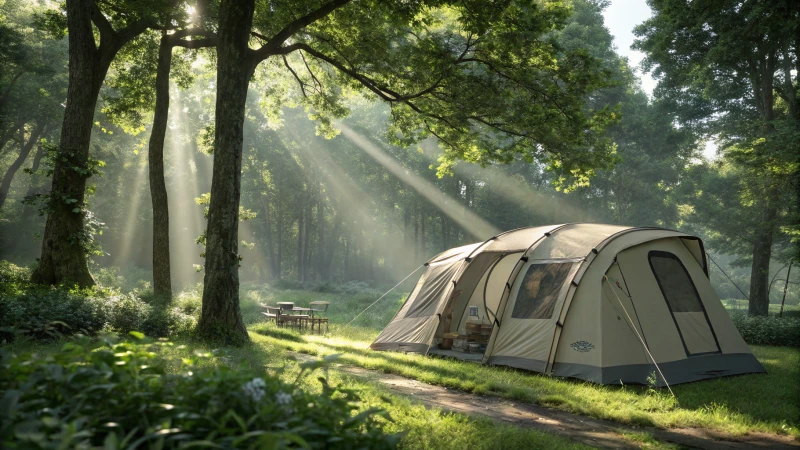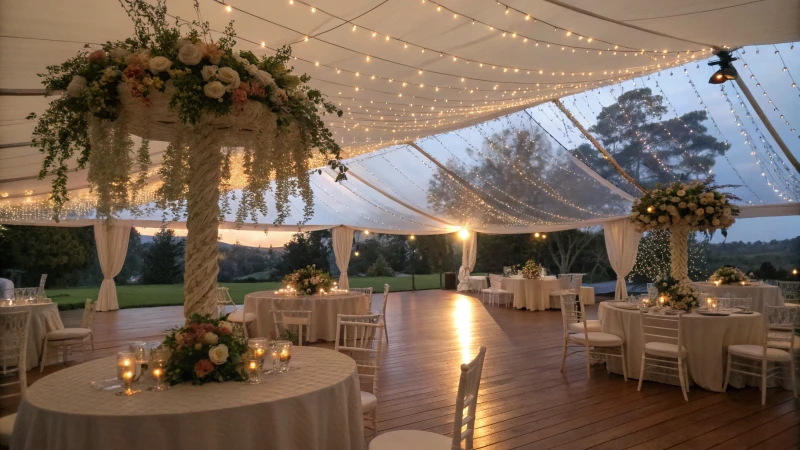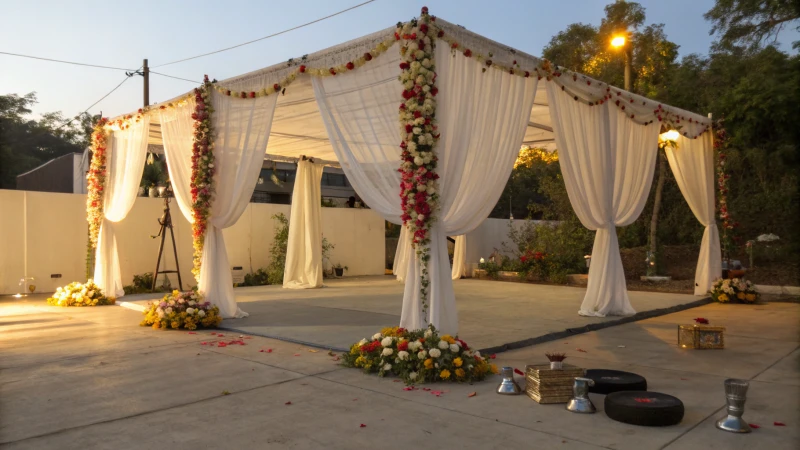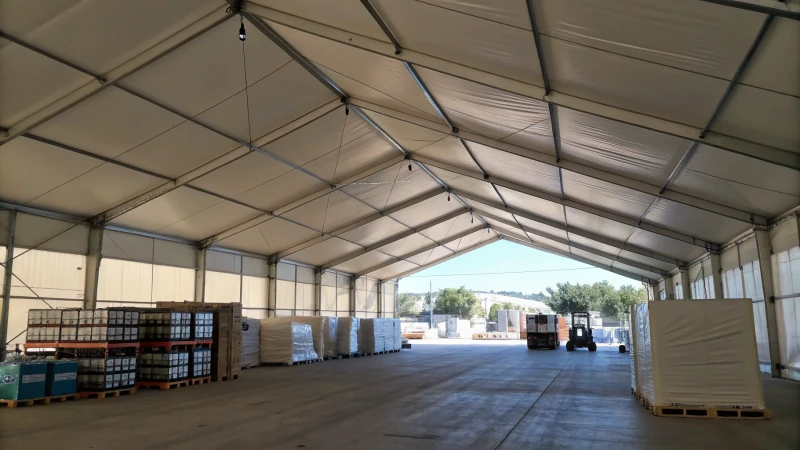
Picture this: You’ve got a bustling warehouse, and you need a tent that’s both spacious and functional. Height is key!
Typically, a warehouse tent boasts sidewall heights of 3 to 6 meters (10 to 20 feet) and peak heights ranging from 4 to 12 meters (13 to 40 feet), providing ample vertical room for your operations.
Thinking back to when I first ventured into the tent business, choosing the right height for a warehouse tent was crucial. It wasn’t just about picking a size off the shelf; it was about understanding the specific needs of the space and how it would be used. For instance, when storing oversized equipment or improving ventilation, standard measurements might not cut it. Customizable options can really make all the difference in meeting unique requirements. Let’s dive deeper into how these factors influence the ideal height for your warehouse tent, ensuring you get the perfect fit for your needs.
Warehouse tents have peak heights up to 40 feet.True
Warehouse tents can reach peak heights of 12 meters, equivalent to 40 feet.
All warehouse tents have sidewall heights under 10 feet.False
Sidewall heights for warehouse tents range from 3 to 6 meters, or 10 to 20 feet.
How Does Tent Height Affect Storage Capacity?
Ever wondered why some tents just seem to swallow up gear while others leave you tripping over everything?
Tent height impacts storage capacity by offering vertical space for organizing and storing items. Taller tents can accommodate larger equipment and enhance organization, optimizing storage efficiency.
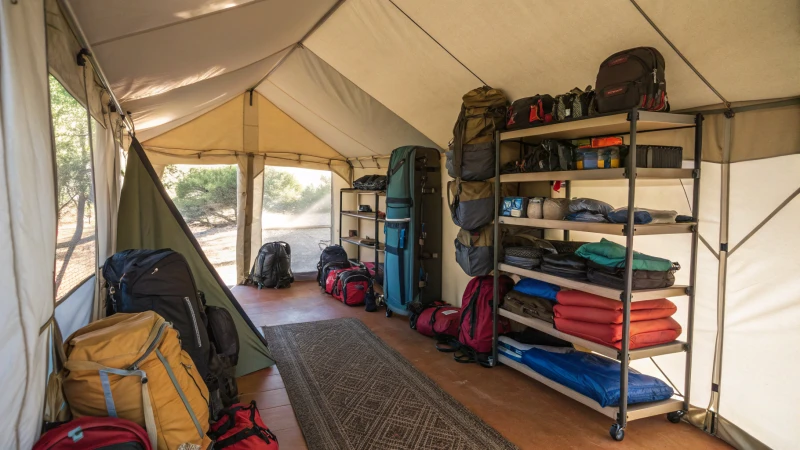
Understanding Tent Dimensions
I remember the first time I set up a tent, thinking it was all about floor space. Little did I know that the height of a tent could change everything about how much stuff you could cram inside—and still find later! Let’s break down the importance of tent dimensions.
Sidewall Height
Sidewall height is like the unsung hero of tent dimensions. It dictates how much usable space you actually have along the edges. Imagine trying to stack boxes or set up shelves—sidewall height determines whether you’re getting practical vertical space or just a sad pile.
- Standard Sidewall Heights:
- 3 meters (10 feet): Perfect for smaller setups or if you’re just starting out with a modest inventory.
- 4 meters (13 feet): This is your sweet spot for medium-sized adventures, where you need a bit more headroom.
- 5–6 meters (16–20 feet): Now we’re talking about serious business—tall racks, maybe even machinery.
I’ve found that adjusting sidewall height gives you that extra flexibility, especially when unexpected storage needs pop up. It’s like having a secret power to fit oversized equipment at the drop of a hat.
Peak Height
Then there’s peak height, which I used to think was all about aesthetics until I realized it was the reason my friend’s tent could fit a kayak vertically. The roof design plays a major role here.
- Standard Peak Heights:
- 4–6 meters (13–20 feet): Common in smaller setups, perfect for when you’re going for a classic look with gable or flat roofs.
- 7–12 meters (23–40 feet): For those grand designs with high-pitched or curved roofs, making sure you’re never short on vertical space.
Different roof shapes influence peak height:
- Gable Roofs: Typically have lower peaks but are great for standard needs.
- Arched or Dome Roofs: These are my personal favorites—not just for the extra space but also for the dramatic look they give.
Factors Influencing Tent Height
From what I’ve seen, choosing the right tent height isn’t just about the space itself but also considering what you’ll be doing inside.
- Intended Use: For tall items like pallets or vehicles, you’ll need those extra high sidewalls and peaks.
- Ventilation Needs: A taller tent allows better airflow and even space for HVAC systems if you’re planning to stay comfy.
- Accessibility: Don’t forget about entry points. Large doors or roll-up shutters may require those higher walls.
- Customization Options: Thankfully, most manufacturers are pretty flexible with adjustable heights to suit exactly what you need.
Example Tent Sizes and Heights
| Tent Size | Sidewall Height | Peak Height |
|---|---|---|
| Small (10x20m) | 3 meters (10 ft) | 4–5 meters (13–16 ft) |
| Medium (20x50m) | 4 meters (13 ft) | 6–8 meters (20–26 ft) |
| Large (30x80m) | 5–6 meters (16–20 ft) | 9–12 meters (30–40 ft) |
I’ve noticed that each size offers unique storage possibilities based on its dimensions, allowing for personalization to match your specific needs. It’s all about finding what fits your lifestyle—or business style—in this case.
Exploring Tent Customization
One of the best parts of my job is helping people discover customization options. By tweaking things like height and layout, you can ensure your tent meets all your storage needs and more. It’s like designing your own little piece of perfection on Earth. If you’re intrigued by adjustable heights, check out the options1 available.
By understanding these dimensions and exploring customization options, I believe anyone can find the perfect tent that not only suits their needs but enhances their operational efficiency and flexibility.
Higher sidewalls increase tent storage capacity.True
Higher sidewalls allow more vertical space for storing taller items.
Gable roofs provide the highest peak height in tents.False
Arched or dome roofs typically offer higher peaks than gable roofs.
Why Choose Customizable Tent Heights?
Ever been under a tent that seemed to fit just right, whether for a wedding or a bustling warehouse? Customizable tent heights might just be the secret ingredient.
Customizable tent heights offer flexibility, allowing for tailored solutions that enhance functionality and aesthetic appeal. By adapting to specific needs, these tents are perfect for diverse events, accommodating tall equipment and creating unique visual experiences.
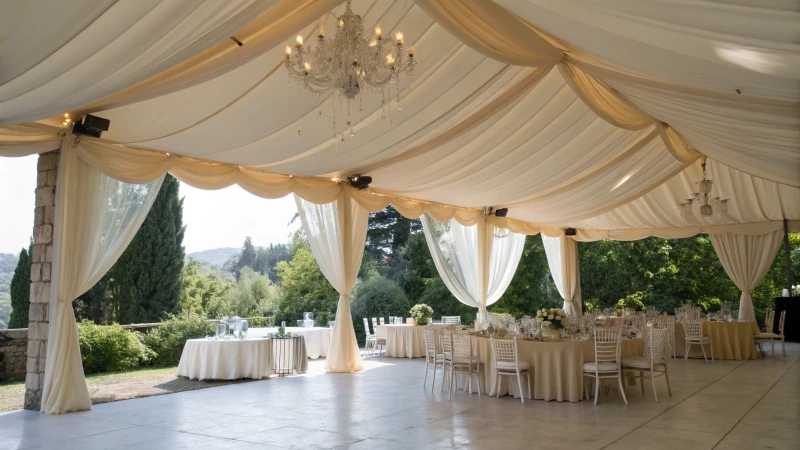
Maximizing Functionality with Custom Heights
I remember the first time I saw a massive warehouse tent that could adjust its height. It was like watching a Transformer in action! This flexibility is a game-changer, especially in industries that need adaptable storage solutions2. Imagine having a tent that can effortlessly house towering machinery or neatly stacked pallets, and then imagine how much easier operations become with that kind of space.
| Tent Size | Sidewall Height | Peak Height |
|---|---|---|
| Small | 3 meters (10 ft) | 4–5 meters (13–16 ft) |
| Medium | 4 meters (13 ft) | 6–8 meters (20–26 ft) |
| Large | 5–6 meters (16–20 ft) | 9–12 meters (30–40 ft) |
These customizable options mean businesses can maximize their space without wasting any. It’s like getting an extra room in your house whenever you need it.
Enhancing Aesthetic Appeal
I once attended a wedding where the tent had this incredible arched roof that left everyone in awe. That’s the power of customizable tent heights. Whether it’s an elegant gable roof for a refined look or an arched one for a grand affair, these tents allow event planners to create exactly the ambiance they envision.
And let’s not forget the decorative elements. With higher peaks, you can hang lavish chandeliers or intricate drapes that captivate guests, turning any event into a memorable experience.
Improved Ventilation and Insulation
Higher tents aren’t just about looks—they’re about comfort too. I can’t tell you how much I appreciated the cool breeze at a summer festival, all thanks to the tent’s superior air circulation. Plus, the extra space accommodates advanced HVAC systems, making any gathering comfortable regardless of the weather outside.
Moreover, customizable heights support enhanced insulation options, contributing to energy efficiency and maintaining a pleasant environment inside the tent.
Versatile Accessibility Options
Flexibility in tent height also means versatility in accessibility. I saw firsthand how easy it was for trucks to drive right into a tent with roll-up shutters during a logistics event. It’s the kind of seamless operation that makes life easier.
By customizing sidewall heights, businesses can tailor their logistical operations to their precise needs, ensuring everything runs smoothly. It’s all about making the space work for you, not the other way around.
Custom tent heights improve air circulation.True
Higher tents allow better air flow, enhancing comfort during large events.
Adjustable tent heights are irrelevant for industrial use.False
They are crucial for housing tall machinery and improving logistical operations.
How Do Different Roof Designs Influence Tent Height?
Ever wondered how the shape of a tent roof could make or break your camping experience or business setup?
Roof designs like gable, dome, and flat significantly impact tent height, influencing both the usability and the available space inside.
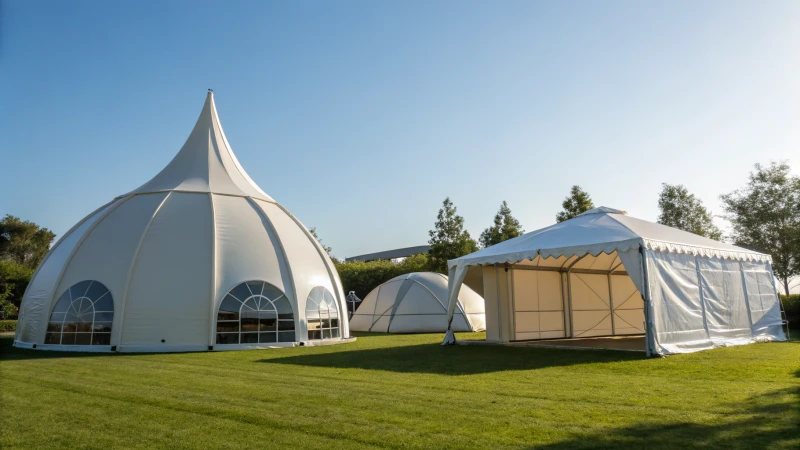
Analyzing Roof Designs and Their Impact
When I first started exploring different tent designs for my business, I realized just how much the roof shape can impact functionality. Picture this: you’re planning an event and need a tent that feels spacious yet fits within a certain footprint. Understanding the impact of roof design3 becomes crucial.
Gable Roofs are like the old trusty friend—reliable and straightforward with two sloping sides that form a triangle. They’re perfect for moderate peak heights, making them ideal for general storage or casual camping trips.
On the other hand, Dome Roofs are the charismatic show-offs in the tent world. With their aerodynamic curves, they offer higher peak heights, which is exactly what you need when hosting events4 that require ample vertical space or when you have tall equipment to accommodate.
Lastly, there’s the Flat Roof, the minimalist of the bunch. While they might not provide much interior height, they’re simple and cost-effective—perfect for when maximizing space isn’t your top priority.
Sidewall vs. Peak Height
I’ve learned through experience that the height of a tent isn’t just about how tall it looks from the outside. It’s all about balancing sidewall and peak measurements. Sidewalls are those reliable vertical edges, while peak height is where your tent hits its tallest point.
| Roof Type | Sidewall Height | Peak Height |
|---|---|---|
| Gable | 3-4 meters | 4-6 meters |
| Dome | 5-6 meters | 7-12 meters |
| Flat | 2-3 meters | Same as sidewall |
Practical Applications
Choosing the right roof design is like picking the perfect outfit—it has to suit the occasion. For instance, when I needed a warehouse tent5 to store vehicles or large machinery, a dome roof was my go-to due to its generous height. In contrast, smaller setups might only need a flat roof.
Climate and weather conditions also play a huge role in this decision. Dome roofs are better at withstanding wind, while flat roofs might struggle with snow or rain collection, potentially compromising stability.
Customization Options
The beauty of working with tent manufacturers is the customization. They can adjust heights based on specific needs, ensuring every tent is a perfect fit for its intended use. This flexibility means I can confidently tailor tents for any unique requirement without worrying about efficiency or safety.
To make an informed choice, I always consider factors like climate, intended use, and budget. Researching options and getting expert advice has been invaluable in ensuring my tents meet practical needs while maintaining high quality standards.
Conclusion
By understanding how different roof designs influence tent height, I’ve been able to select optimal structures tailored to various needs. This knowledge has proven essential in making decisions that ensure tents are practical and reliable across diverse settings. For anyone looking to make the best choice for their requirements, I can’t stress enough the importance of research and expert consultation.
Gable roofs offer the highest peak height.False
Dome roofs provide higher peak heights compared to gable roofs.
Flat roofs have the same sidewall and peak height.True
Flat roofs maintain uniform height, with no additional peak.
How Do You Choose the Right Tent Height?
Imagine setting up a tent that fits like a cozy glove, where every inch of height meets your needs perfectly.
Consider factors like your tent’s purpose, user height, climate, and gear space when choosing the right tent height. Taller tents offer more ventilation and comfort, while shorter ones provide compactness and better heat retention.
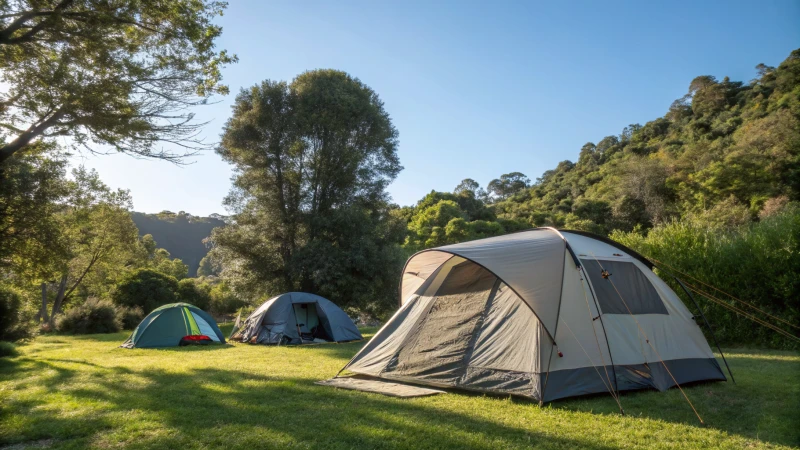
Understanding Tent Usage
When I think about camping, I remember a trip where the tent was too low for me to even sit up without knocking my head against the ceiling. Lesson learned! The right height makes a huge difference. For camping, you want a tent where you can stand, sit, and move without feeling like you’re in a hobbit hole. If you’re considering a warehouse tent, it’s crucial to think about storage needs6, whether that’s tall machinery or just extra space for equipment.
User Height and Comfort
I always think about my tallest friend when picking a tent. You don’t want someone ducking down the whole trip—it just dampens the fun. So, if you’re like me and have a tall crew, opt for tents like dome or cabin styles that offer higher peak heights7. It’s all about ensuring everyone can move around comfortably.
Climate and Weather Conditions
Remember that sweltering night where I couldn’t get any air in my tent? That’s why tent height matters! In cooler climates, lower tents help keep the heat in, while taller tents in hot conditions allow for better airflow. Consider models with ventilation systems8 to avoid waking up in a sauna.
Space for Gear and Activities
If you’re anything like me, packing light is not my forte. Your tent needs to fit your gear as well as your gang. Whether it’s camping gear or setting up tables for an event, make sure your tent’s height can handle it all. For events or storage tents, think about the space needed for activities or operational tasks involving equipment9.
Tent Structure and Design
Choosing a tent is like picking a home away from home. Different designs offer varied heights. Dome tents usually have a higher central point, while cabin tents provide uniform headroom throughout. I love the arched roofs—not just for their looks but also for the extra room they offer. Consider these when selecting a tent to suit your specific needs10.
| Tent Type | Typical Sidewall Height | Typical Peak Height |
|---|---|---|
| Small Tents | 1.5-2m (5-7ft) | 2-3m (7-10ft) |
| Medium Tents | 2-3m (7-10ft) | 3-4m (10-13ft) |
| Large Tents | 3-4m (10-13ft) | 4-5m (13-16ft) |
Customizable Options
One of the coolest things I’ve found is that many manufacturers offer customizable heights—perfect for events where you want everything just so. Whether it’s for aesthetic purposes11 or specific storage needs, customization lets you tailor your tent without sacrificing utility or comfort.
Taller tents are better for hot climates.True
Taller tents allow better airflow, reducing heat and humidity inside.
Dome tents offer uniform headroom throughout.False
Dome tents have a higher central point but lower sidewalls compared to cabin tents.
Conclusion
Warehouse tents typically have sidewall heights of 3-6 meters and peak heights ranging from 4-12 meters, providing ample vertical space for storage and operations.
-
Explore how adjustable tent heights can tailor to specific storage needs, providing greater flexibility and efficiency in space utilization. ↩
-
Explore how customizable warehouse tents can optimize space and functionality for various storage and operational requirements. ↩
-
Discover how different roof designs affect the usability and functionality of tents in diverse applications. ↩
-
Explore why dome roofs are advantageous for events requiring ample vertical space and aesthetic appeal. ↩
-
Learn about effective warehouse tent designs that provide ample space for storage and operational needs. ↩
-
Learn how to accommodate tall items like machinery or racks in warehouse tents. ↩
-
Explore which tent styles offer higher peak heights for more headroom. ↩
-
Discover options for integrating ventilation systems to enhance air flow. ↩
-
Get insights on managing space efficiently within event tents. ↩
-
Examine how different tent designs impact height and usability. ↩
-
Find out how customized tent designs can meet specific aesthetic needs. ↩


